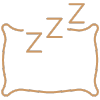 30 nights trial sleep & free returns
30 nights trial sleep & free returns
 1,000+ customers already sleep better
1,000+ customers already sleep better
 Handmade bedding in manufacturer quality
Handmade bedding in manufacturer quality
 Sustainable & ethically sourced materials
Sustainable & ethically sourced materials